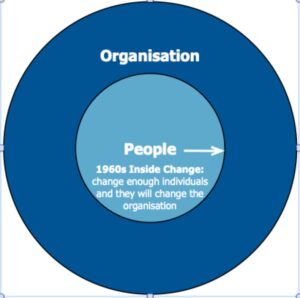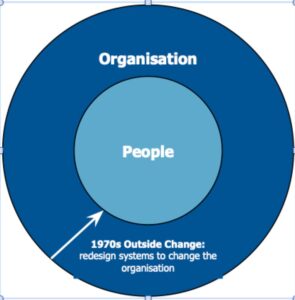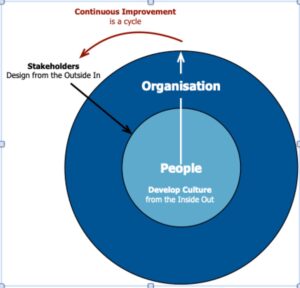Organizational Transformation is the latest term for moving an organization to better results. Though the term may be new, the dynamics of making change happen remain unchanged. A brief look at history may help us all avoid repeating past mistakes.
In the 1960s the field of organization development practiced the notion that in order to change a company’s results, you first had to change individual associates in that company. This graphic illustrates the “inside approach” to change. It was characterized by training seminars and personal growth experiences. Many people were helped by this approach, but only a very few organizations actually improved their results.
In the 1970s, conventional wisdom called for a “systems approach” by addressing issues such as strategy, structure, reward systems, and team effectiveness. This “outside approach” rewired much of how work was done. But research showed that only 25-30 per cent of these approaches actually improved results.
This outside approach to change or transformation is the dominant method still used today – with the same bottom line as before.
My work with several corporations has revealed that both of these approaches are important, but the sequencing and connecting of them is the secret key that unlocks true transformation.
As the global marketplace has taught us, you have to begin with a focus on your customers and other stakeholders. Such “outside-in” planning requires the design of organizational processes, systems, and culture aimed to meet these stakeholder needs.
But people often oppose change – especially if it rattles their comfort zone for no apparent good reason. Thus the need for step two in the transformation process: you must develop the culture (how people think and act) from the inside out. When these two steps are repeated periodically to ensure your enterprise is always aligned with evolving stakeholder needs, you achieve the elusive capability for continuous improvement.
A good example of this “outside-in,” “inside-out” cycle is the case of New Zealand’s Ballance Agri-Nutrients Limited, a successful farmers-owned co-operative. In 2008 Greg Delaney, then general manager of Ballance’s distribution and logistics operation, launched a transformation initiative. External consultants helped Ballance use new Information Technology that led to new operating processes and support systems to address farmer and associates issues. But Greg realized that the technical changes alone would not deliver the improvements. Therefore he invested much of his own time to talk with associates and farmers and found collaborative ways to address their questions and concerns and tweak the new systems. People and technology became aligned in a three-year process that transformed productivity and operations to record highs. Greg observed, “The key to successfully leading change is committing to changing yourself first. Changing my priorities and committing time and effort to the program was the best way to show everyone how serious I was about the change.”
When people change the way they think and behave at work to align with what external stakeholders require, the resulting transformation elevates everyone.
Headline results from a 2010 McKinsey global study on organizational transformation:
| Approach | Entirely/Very Successful Transformations | Not Successful Transformations |
|
Collaborative employee engagement
|
85% | 1% |
|
Building organizational capabilities
|
44% | 5% |
|
Identifying and changing associate mindsets that need to change
|
77% | 15% |
|
Focus on strengths as well as problems
|
58% |
20% |
These survey results underscore lessons I have learned from my involvement in transformations. I have found these steps make all the difference between success and failure:
- Outside-In
- Survey your key stakeholders and monitor how well you are meeting their needs.
- Involve a representative group of associates to diagnose why you are getting the best and worst results today.
- Then have these associates reshape strategy, processes, and systems to fulfil the key stakeholder needs.
- Inside-Out
- Commit yourself personally to do what is essential to accomplish the transformation.
- Teach others how important the transformation is by listening to their questions and concerns, by clarifying what needs to change and why, and by giving feedback to those who do/do not change.
Keep communicating with those who are opposing the change. Tie everything back to the stakeholder needs. Collaborate to find a way forward that most will support.
This article first appeared i InsideHR magazine https://www.insidehr.com.au/the-key-to-organisational-change/ Feb 17, 2015




